Natural spices in your kitchen can effectively combat food spoilage while enhancing flavor. You'll find sea salt and pink Himalayan salt work as powerful preservatives by controlling moisture and supporting beneficial bacteria. Black pepper's piperine fights harmful microbes, while cumin's antibacterial properties make it ideal for preserving fish and meat. Mustard seeds, when combined with vinegar, create an inhospitable environment for bacteria. Garlic's allicin, ginger's natural compounds, and lemon's acidity all contribute to food preservation. Sugar and honey provide additional preservation methods through moisture control. These time-tested ingredients reveal a world of food preservation possibilities in your home kitchen.
Sea Salt and Pink Salt
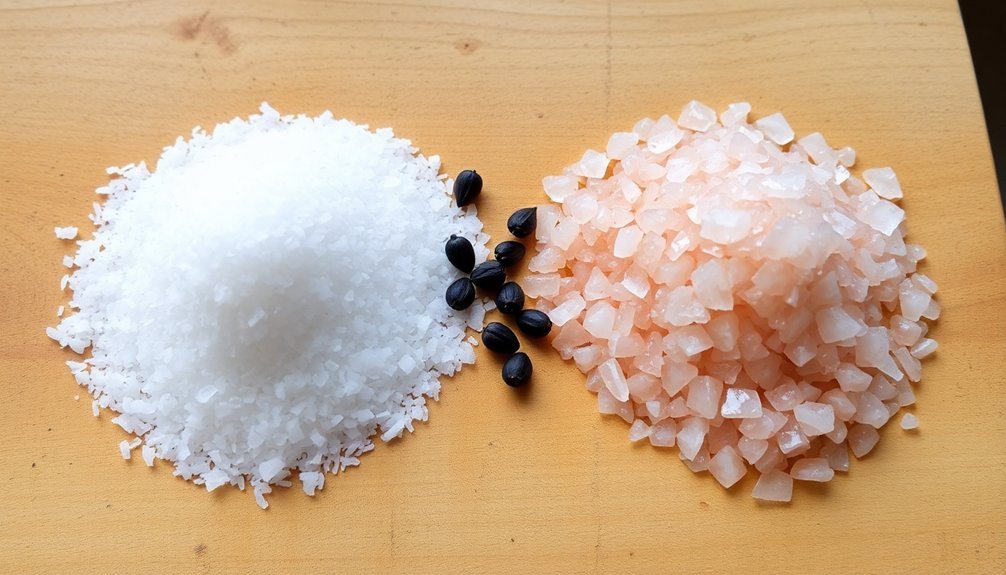
Whether you're preserving meats or fermenting vegetables, sea salt and pink Himalayan salt are powerful natural preservatives that fight food spoilage. These salts work by extracting moisture from food, creating an environment where harmful bacteria, yeasts, and molds can't survive.
Salt amounts and concentrations create high osmotic pressure that destroys microbial cells. Through osmosis, high salt concentrations disrupt microbial cells and change the food's pH level, making it more acidic and inhospitable to spoilage-causing organisms.
You'll find these salts particularly effective in promoting beneficial bacterial growth during fermentation. They're essential for making foods like sauerkraut, kimchi, and pickles, where they support lactic acid production while preventing harmful bacteria from taking hold.
Pink Himalayan salt's mineral content specifically supports the good microbes needed for successful fermentation.
When you're curing meats or fish, both sea salt and pink salt excel at drawing out moisture while concentrating flavors and creating signature textures.
You'll want to use coarse-grained varieties rather than table salt, as they're more effective for preservation. Pink Himalayan salt offers the added benefit of a subtle sweet flavor and lower sodium content, making it an excellent choice for both preservation and taste enhancement.
Whole and Ground Black Pepper
Along with salt, black pepper stands as one of nature's most effective food preservatives. You'll find it's particularly potent against harmful bacteria like Staphylococcus aureus and E. coli, thanks to its active compound, piperine, which creates inhibition zones ranging from 8-18mm around bacterial colonies. Originally introduced to Western cultures during Alexander the Great's conquest, black pepper quickly became valued for both its preservation abilities and flavor.
You can use black pepper in both its whole and ground forms to preserve various foods. Add whole peppercorns to your pickling solutions alongside vinegar and salt to protect vegetables from spoilage. For jams and similar preserves, you'll want to use ground black pepper, which effectively prevents bacterial and fungal growth.
When you're preserving food at home, you can maximize black pepper's antimicrobial properties by storing it correctly in a cool, dry place. You'll get the best results by grinding whole peppercorns fresh, as this maintains their potency.
For everyday use, add ground black pepper to your foods not only for flavor but also to naturally extend their shelf life.
Remember that while black pepper is safe and natural, you shouldn't overuse it, as excessive amounts can cause stomach discomfort. It's an excellent alternative to chemical preservatives, offering both antimicrobial protection and health benefits.
Ancient Cumin Preservation Methods
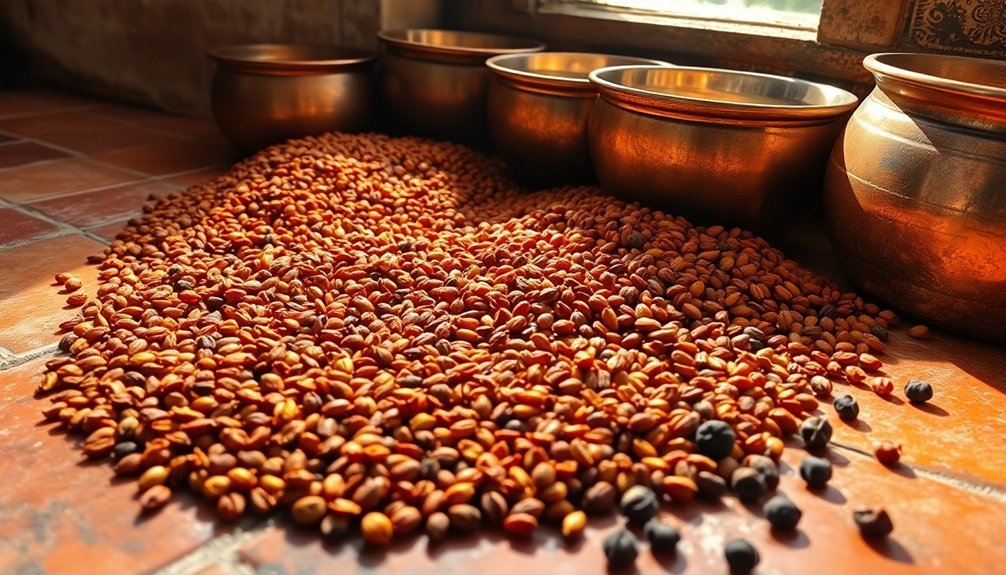
Through the ages, cumin has proven itself as a remarkable preservative, most importantly in Ancient Egypt where it played an essential role in mummification. The spice's powerful antibacterial properties helped dry and protect corpses from decay, making it an integral part of the embalming process.
You'll find cumin's preservation capabilities extend far beyond its funeral uses. Ancient cultures discovered that adding cumin to food could greatly extend its shelf life, particularly in fish preservation. The Celts remarkably baked fish with cumin to keep it fresh longer, while Greeks and Romans incorporated it into dishes specifically to prevent spoilage. Medieval Europeans regarded cumin so highly that it was accepted as rent payment between 800 A.D. and 1200 A.D.
To maximize cumin's preservation power, ancient civilizations developed specific storage methods that you can still use today:
- Store in completely dry conditions away from direct sunlight
- Keep in sealed containers to prevent moisture and air exposure
- Maintain consistent temperature in storage areas
The spice's cultural significance in preservation rituals continues to this day, appearing in traditional foods like Greek kolyva.
While modern preservation methods have evolved, cumin's natural antibacterial properties remain as effective now as they were thousands of years ago.
Mighty Mustard Seeds
You'll find mustard's natural preservative compounds, including myrosinase and glycosides, create an inhospitable environment for bacteria when added to raw proteins like meat or fish.
By combining mustard seeds with vinegar or other acidic ingredients, you're enhancing its natural antibacterial properties and extending the shelf life of your foods.
Even the leftover mustard plant material won't go to waste, as farmers have discovered its effectiveness as a natural biofumigant to suppress soil diseases and reduce the need for chemical pesticides.
Preserving Raw Protein Foods
When it comes to preserving raw protein-rich foods, mustard seeds pack a powerful punch with their impressive 28-32% protein content and natural antimicrobial properties.
You'll find these tiny powerhouses particularly effective when you're looking to extend the shelf life of your protein-rich foods while adding nutritional value.
To maximize mustard's preservative potential, you can use it in several ways:
- Grind fresh mustard seeds into a fine powder and mix it into your meat marinades – the protein content will help bind moisture while its natural compounds fight spoilage for up to 6 months.
- Create a mustard-based emulsion coating for raw proteins before storage – its excellent fat and water binding properties will help maintain food quality.
- Incorporate mustard flour into your protein-rich food preparations – its mid-40% protein content complements other proteins while acting as a natural preservative.
You don't need to worry about the mustard overwhelming your food's flavor, as proper storage in cool, dry places maintains its effectiveness without intensifying its taste.
Remember to check for signs of deterioration like dull appearance or faded color to guarantee your preservative remains potent.
Natural Antibacterial Properties
Ever wonder what makes mustard seeds such powerful natural preservatives? These tiny powerhouses contain compounds like 4-hydroxy-3-nitrophenylacetic and sinapic acids that naturally fight harmful bacteria such as E. coli, Salmonella, and Staphylococcus aureus.
When you add water to crushed mustard seeds, you'll activate their glucosinolates, which break down into potent antimicrobial substances called isothiocyanates.
You can harness mustard's antibacterial properties in your kitchen by using mustard powder as a natural preservative. Adding just 2% mustard powder to meat can reduce bacteria to undetectable levels for up to two days.
You'll find it's particularly effective in ground beef, where it can eliminate dangerous strains like E. coli O157:H7 while improving the meat's sensory qualities.
The secret lies in mustard's unique chemical structure. Its hydroxyl and nitro groups, along with methoxyl components, work together to disrupt bacterial metabolism and damage cell membranes.
Mustard Seed Waste Uses
Transforming mustard seed waste into valuable products has revolutionized the food industry's sustainability efforts. When manufacturers press mustard seeds for oil, they're left with defatted seed meal that traditionally held little economic value.
Now, you'll find this by-product serving multiple purposes in both industrial and household applications.
You can harness the power of mustard seed meal in several practical ways:
- Natural pest control: Its pungent properties make it an effective fumigant against household pests, including ants and mice, offering you a safer alternative to chemical pesticides.
- Eco-friendly cleaning: The meal's acidic properties make it useful as a natural cleaning agent that's safe around children and pets.
- Weed management: You can use it as a selective herbicide to control annual weeds in your garden without harsh chemicals.
Scientists have also discovered valuable compounds within the meal, particularly sinapic acid and its derivatives, which offer antimicrobial benefits.
These findings have opened doors for natural food preservation methods. When you choose products containing these mustard-derived preservatives, you're not only protecting your food but also supporting sustainable practices that transform industrial waste into useful resources.
Fresh Ginger Applications
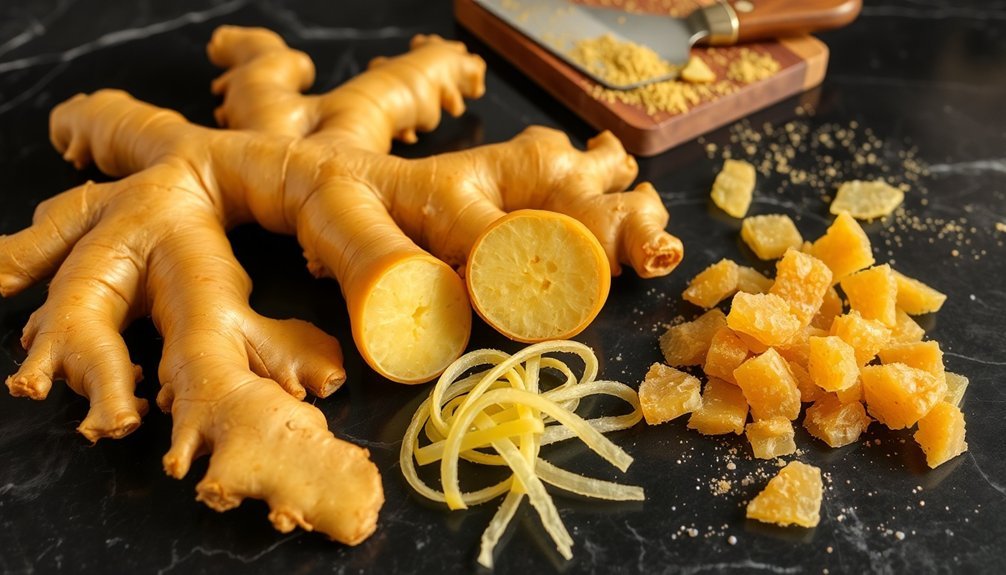
Fresh ginger's power to fight food spoilage shines through in marinades, where you'll find its natural compounds help tenderize meat while extending its shelf life.
You can preserve ginger tea by freezing it in ice cube trays or storing it with honey, making it readily available for both medicinal and culinary uses.
While dried ginger offers convenience and concentrated flavor, fresh ginger provides more potent antimicrobial properties and a broader range of beneficial compounds for food preservation.
Ginger Tea Preservation Methods
The preservation of ginger's potent properties is essential for maintaining a steady supply of flavorful tea ingredients.
You'll find that proper storage methods can extend your ginger's life considerably, ensuring you've always got fresh ingredients for your favorite brews.
Whether you're using the refrigeration, freezing, or alcohol preservation method, you'll be able to keep your ginger ready for tea-making year-round.
1. For regular tea brewing, store your unpeeled ginger in the fridge's crisper drawer using an airtight container or resealable bag – it'll last up to a month this way.
If you've already peeled your ginger, wrap it tightly in plastic wrap to prevent oxidation.
2. When you're planning for long-term tea preparations, freeze your ginger whole or in pieces.
You can grate it directly from frozen into your tea, and it'll keep for up to 6 months.
3. For a unique twist on traditional ginger tea, try preserving sliced ginger in vodka or brandy.
While it'll retain some alcohol flavor, this method keeps your ginger usable for 1-2 months and can add an interesting dimension to your hot beverages.
Marinades With Fresh Ginger
Beyond its role as a tea ingredient, ginger's remarkable tenderizing properties make it a powerhouse addition to marinades. Fresh ginger contains zingibain, an enzyme that's more effective at breaking down meat's tough connective tissues than enzymes found in pineapple, papaya, or figs. You'll want to use fresh ginger, as ground ginger loses its tenderizing abilities.
For best results, select ginger with smooth skin and a spicy fragrance. Peel and grate it just before use to preserve its volatile oils. You can store unused ginger in your freezer for up to 4 months, grating it frozen when needed.
| Marinade Type | Fresh Ginger Amount |
|---|---|
| Basic Teriyaki | 1 tbsp minced |
| Tough Meat | 2 tbsp grated |
| Quick Flavor | 1/2 tbsp minced |
| Asian-Style | 1 tbsp grated |
| BBQ Enhancement | 1 tbsp minced |
When making marinades, combine fresh ginger with ingredients like soy sauce, ketchup, and vinegar. For tough cuts like venison, you can marinate for up to 4 days, while tender cuts need only 8-12 hours. Remember to refrigerate during marination and turn the meat occasionally for even distribution.
Dried Versus Fresh Benefits
While marinades showcase ginger's tenderizing power, comparing fresh versus dried ginger reveals distinct advantages for food preservation and flavor. Fresh ginger offers superior antioxidant properties that can help preserve your food naturally, without the need for synthetic additives like BHT and BHA. You'll find it's particularly effective at preventing lipid oxidation and reducing microbial growth in your dishes.
- Fresh ginger maintains its potency for up to three weeks at room temperature and even longer when refrigerated, making it a practical choice for regular cooking. You can extend its shelf life by freezing it for 3-4 months, and you won't even need to thaw it before grating.
- While dried ginger is convenient, fresh ginger provides more versatile applications in your kitchen, from flavoring soups and stews to creating preservative-rich marinades that enhance both taste and shelf life.
- For ideal preservation benefits, choose fresh ginger with smooth skin and firm texture. You'll know it's still effective when it maintains its natural color without any dark spots or wrinkles, ensuring maximum antioxidant properties for your food preservation needs.
Powerful Garlic Protection
Inside every clove of garlic lies powerful antimicrobial properties that can help protect your food from spoilage. The key compound, allicin, works against both Gram-positive and -negative bacteria, while also fighting viruses, fungi, and parasites. It attacks harmful microorganisms by modifying their proteins, effectively destroying them.
You'll find several methods to harness garlic's protective qualities while preserving it for extended use. If you're looking for a quick solution, try refrigerating garlic in vinegar. Simply boil the vinegar, pour it over clean cloves in small jars, and refrigerate after cooling – it'll last up to a year.
For a more precise approach, you can acidify your garlic using citric acid. Mix chopped garlic with a 3% citric acid solution at a 1:3 ratio, ensuring the pH drops below 4.2.
Or try the confit method by slowly simmering peeled cloves in oil until they're golden. Store your confit in sterile jars and keep them cold for 3-6 months, or freeze them for longer storage. As a bonus, you'll get flavored oil that carries garlic's protective compounds.
Lemon Preservation Techniques
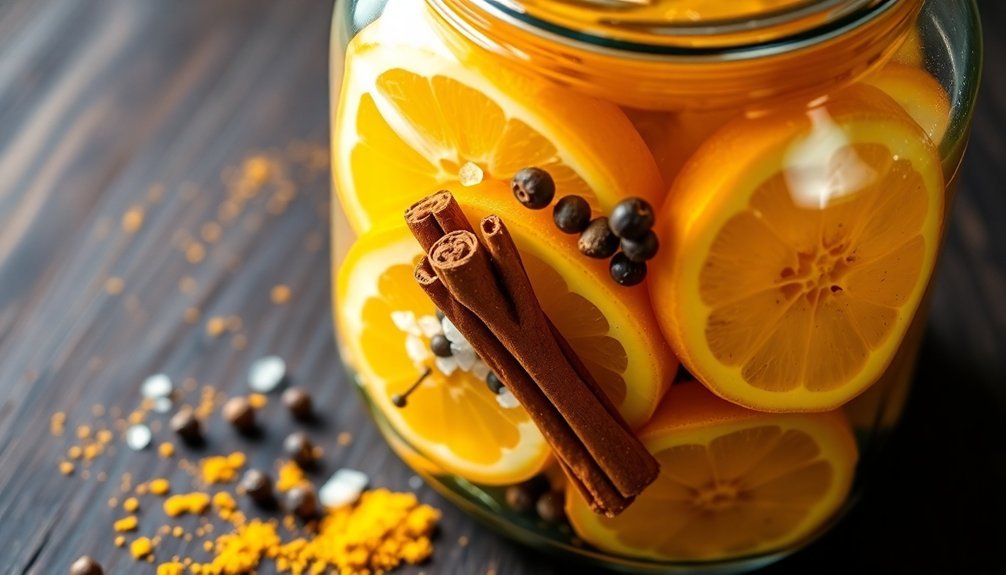
Nature's citrus warriors, lemons pack a powerful preservative punch through their natural acidity and antimicrobial properties.
You'll find that preserving lemons isn't just about extending their shelf life – it's about transforming them into a powerful flavor enhancer that fights spoilage while adding depth to your dishes.
To create preserved lemons, you'll need organic fruits (since you'll be eating the rind), kosher salt, and sterilized jars. The process is straightforward but requires patience:
- Cut your lemons into quarters while keeping them attached at the base, stuff them with salt, and pack them tightly into sterilized jars.
- Press the lemons firmly to release their juices, add additional fresh lemon juice until they're fully submerged, and shake periodically to distribute the salt.
- Let them ferment at room temperature for 2-3 weeks, then refrigerate for up to a year.
You'll know your preserved lemons are ready when the rinds become soft and develop a unique umami-like flavor.
Keep them submerged in their brine to prevent mold, and always check for signs of spoilage before use.
They're perfect for adding to tagines, salad dressings, or sauces.
Vinegar Storage Solutions
Keep an eye out for signs that your vinegar's gone bad. If you notice an acetone smell (like nail polish remover) or a funky odor, it's time to discard it.
You should taste-test your vinegar every six months, even if it looks fine. Different types have varying shelf lives – wine vinegars typically last two years, while balsamic varieties can age well for many years when stored correctly.
Sugar Preservation Methods
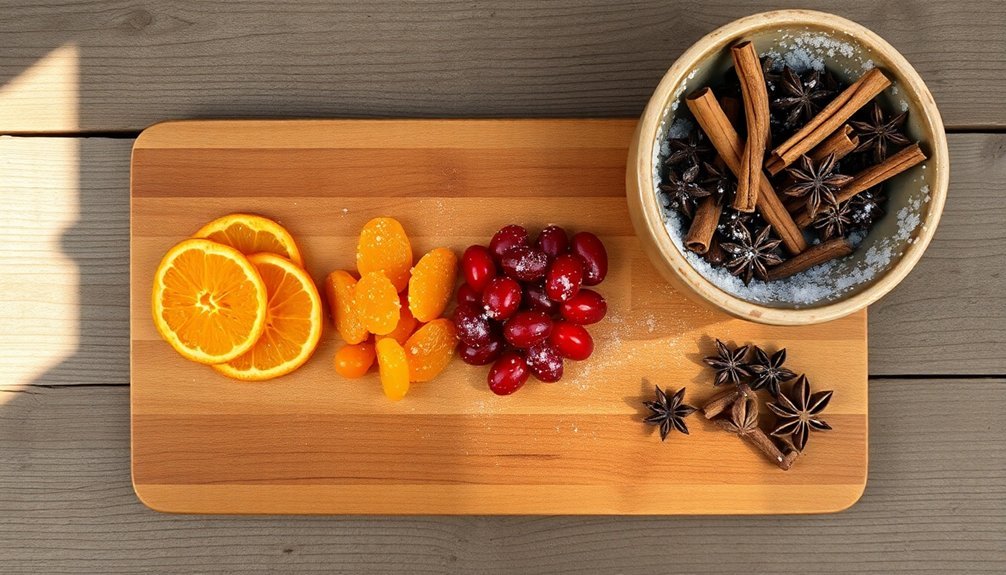
You'll find that sugar preservation methods offer multiple ways to extend your food's shelf life, from creating concentrated sugar syrups to coating items with crystalline sugar for dehydration.
When working with sugar syrups, maintaining proper concentration levels is essential, as too little sugar won't effectively prevent bacterial growth, while too much can lead to crystallization.
For an enhanced preservation effect, you can combine honey with granulated sugar, taking advantage of honey's natural antibacterial properties while achieving ideal moisture control through the crystalline structure of regular sugar.
Sugar Syrup Storage Basics
Properly storing sugar syrups requires attention to both storage conditions and preservation techniques. You'll need to keep your syrups in cool, dry locations while avoiding extreme temperatures that can cause crystallization or darkening. If you're storing simple syrups, refrigeration is essential to extend their shelf life, though granulated sugars should stay at room temperature.
Choose your storage containers carefully to maintain syrup quality. Airtight, moisture-proof containers like Mason jars or glass bottles work best, but avoid containers with pour spouts or corks that can let air in. For acidic syrups, use lined, food-grade metal containers to prevent rust.
To maximize your syrup's shelf life, follow these preservation methods:
- Increase sugar content to at least 50% brix (equal parts sugar and water by weight)
- Add citric acid or vinegar to create a preservative environment
- Use hot fill methods, heating the syrup to at least 120 degrees before bottling
Monitor your syrups regularly for signs of spoilage, and track preparation dates. Simple syrups typically last one to three months in the fridge, but you can extend this by freezing them in ice cube trays for convenient storage.
Dehydrating With Sugar Crystals
When combining sugar crystals with dehydrated spices, you're creating a powerful preservation duo that maximizes shelf life and enhances flavor. The sugar's ability to reduce water activity complements the antimicrobial properties of spices like cinnamon and cloves, giving you a natural way to protect your food from harmful bacteria and spoilage.
To get the best results, you'll need to guarantee your spices are thoroughly dehydrated using a dehydrator with silicone mats. This process concentrates the spices' antioxidants and preserves their potency.
Once dried, combine them with sugar crystals in research-tested proportions to create an effective preservative blend.
You'll find this method particularly useful when making jams, jellies, and fermented products. The sugar crystals draw moisture away from the food while the spices fight against E. coli, Salmonella, and other microorganisms.
Remember that ground spices lose their potency faster than whole ones, so you'll want to store your sugar-spice mixture in a cool, dark place. When properly prepared and stored, your preserved foods can maintain their quality and safety for up to a year.
Honey-Sugar Mixed Preservation
The combination of honey and sugar creates a formidable preservation method that maximizes both ingredients' natural antibacterial properties. When you're mixing honey and sugar for preservation, you'll need to store your preserves in glass containers, as plastic can compromise the quality and effectiveness of the mixture.
Keep your preserved foods in a dark place at room temperature, ideally between 10 and 20 degrees Celsius.
- Always use glass containers with hermetic seals to prevent oxygen exposure, and don't fill them completely if you're planning to freeze the preserves, as honey expands at low temperatures.
- Mix raw honey with sugar in precise ratios (¼ cup honey per 3 cups of preserved food) to maintain ideal preservation conditions.
- Watch for crystallization, which isn't harmful but might affect texture – you can gently warm the mixture in a hot water bath if needed, but never microwave it.
If you're combining honey and sugar for fermentation, verify you're using raw honey for its beneficial cultures.
Your equipment must be thoroughly sanitized, and you'll want to use fermentation jars with tight seals to prevent mold growth, which can quickly spread throughout the entire preserve.
Spicy Cayenne Storage Tips
Savvy cooks understand that storing cayenne pepper correctly makes a significant difference in preserving its fiery kick and vibrant flavor.
You'll want to keep your cayenne in airtight glass jars or metal tins, placing them in a cool, dark spot where temperatures stay between 60-70°F.
While your ground cayenne can last 3-4 years and whole dried peppers up to 5 years, proper storage is essential to maintain their potency.
Don't store your cayenne near the stove or dishwasher, as heat will degrade its quality faster. Instead, opt for a dark cupboard away from direct sunlight to prevent color fading and flavor changes.
You've got several options for long-term storage. Freezing can preserve cayenne's heat and flavor for up to a year – just seal it tightly in freezer bags with the air removed.
For even longer preservation, you can vacuum-seal cayenne in Mylar bags with oxygen absorbers, extending its life to 2-5 years.
Remember to avoid refrigeration, as it can lead to moisture buildup and mold. If you're concerned about humidity, add silica gel packets to your storage containers to absorb excess moisture.
Frequently Asked Questions
How Long Can Spices Maintain Their Preservative Properties in Storage?
You'll find most spices maintain their preservative properties for 2-3 years when stored properly. However, cloves and nutmeg can last 4-5 years, while ginger's properties diminish after just 1-2 years.
Can Different Preservation Spices Be Combined for Enhanced Effectiveness?
Yes, you'll get stronger preservative effects by combining spices. Try mixing thyme with rosemary for meat, or blend cinnamon and clove. These combinations work better together than single spices for preservation.
Which Spices Work Best for Preserving Different Types of Meat?
You'll want to use garlic and black pepper for beef, ginger and mustard for pork, sage and paprika for chicken, and turmeric and cumin for lamb. These combinations protect and enhance each meat's flavor.
Do Organic Spices Have the Same Preservation Capabilities as Conventional Ones?
Yes, you'll find organic spices have similar preservation capabilities as conventional ones. Their antimicrobial properties remain intact, and they're often more potent since steam sterilization better preserves their active compounds.
What Temperature Conditions Maximize the Preservative Effects of Common Spices?
You'll get the best preservative effects from spices at moderate temperatures (60-75°F/15-24°C). While they'll still work in warmer conditions, you'll need higher concentrations of spices to achieve the same preservation results.
In Summary
By using these natural spices and preservation methods, you'll extend your food's shelf life while adding delicious flavors to your dishes. Whether you're preserving with salt, creating pickles with vinegar, or adding antimicrobial spices like ginger and cumin, you're choosing time-tested techniques that work. Start experimenting with these methods today, and you'll reduce food waste while saving money in your kitchen.

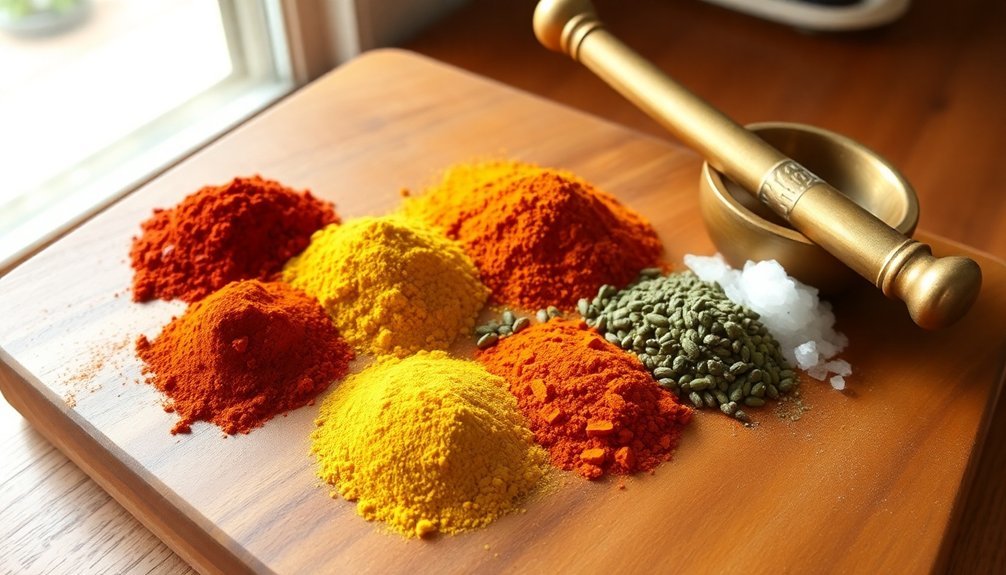



Leave a Reply